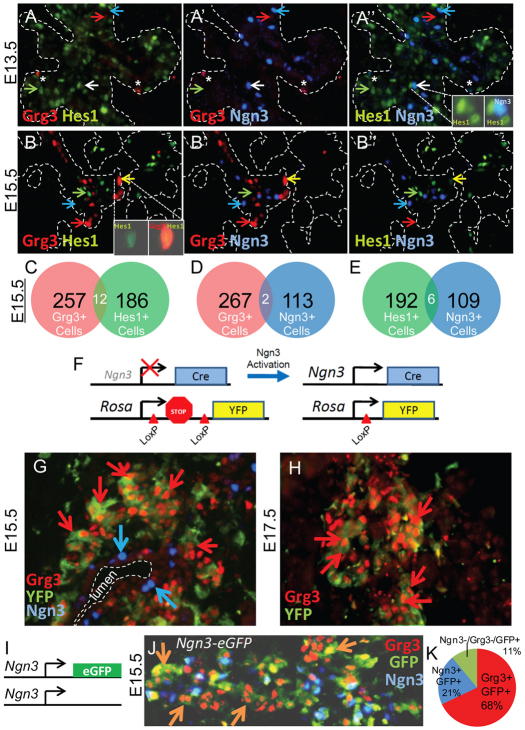Fig. 3.
Grg3 is expressed in descendants of Ngn3+ endocrine progenitors. (A-B″) E13.5 and E15.5 pancreas sections were triple-stained for Grg3, Hes1 and Ngn3. Red arrows indicate Grg3+ cells that express neither Hes1 nor Ngn3; green arrows indicate Hes1+ cells that express neither Grg3 nor Ngn3; blue arrows indicate Ngn3+ cells that express neither Grg3 nor Hes1; yellow arrows indicate a rare Grg3/Hes1 double-positive cell; white arrows indicate a rare Hes1/Ngn3 double-positive cell (A,B). Asterisks indicate autofluorescing cells. (C-E) Grg3/Hes1, Grg3/Ngn3 and Hes1/Ngn3 double-positive cells were quantitated at E15.5, revealing that these factors are rarely co-expressed in the same cells. (F) Lineage-tracing strategy in which Cre recombinase is driven from the Ngn3 promoter deleting a LoxP flanked transcriptional ‘stop’ and activating a YFP reporter driven by the Rosa gene. (G) E15.5 pancreas sections from this cross were analyzed for Grg3, YFP and Ngn3. Ngn3+ cells near the trunk lumen (blue arrows) express neither YFP nor Grg3 (red arrows). However, Grg3 is highly expressed in YFP+ Ngn3 descendants. (H) At E17.5, Grg3 persists in YFP+ Ngn3 descendants (red arrows). (I,J) Analysis of E15.5 pancreas of Ngn3-eGFP (I) embryos reveal that Grg3 is expressed in Ngn3–/GFP+ newly differentiating endocrine cells (J, orange arrows). (K) Of 877 GFP+ cells counted, Grg3 is expressed in 68% of total GFP cells (86% of Ngn3–/GFP+ cells), Ngn3 is expressed in 21% total GFP cells, whereas Ngn3–/Grg3–/GFP+ cells represent 11%.

